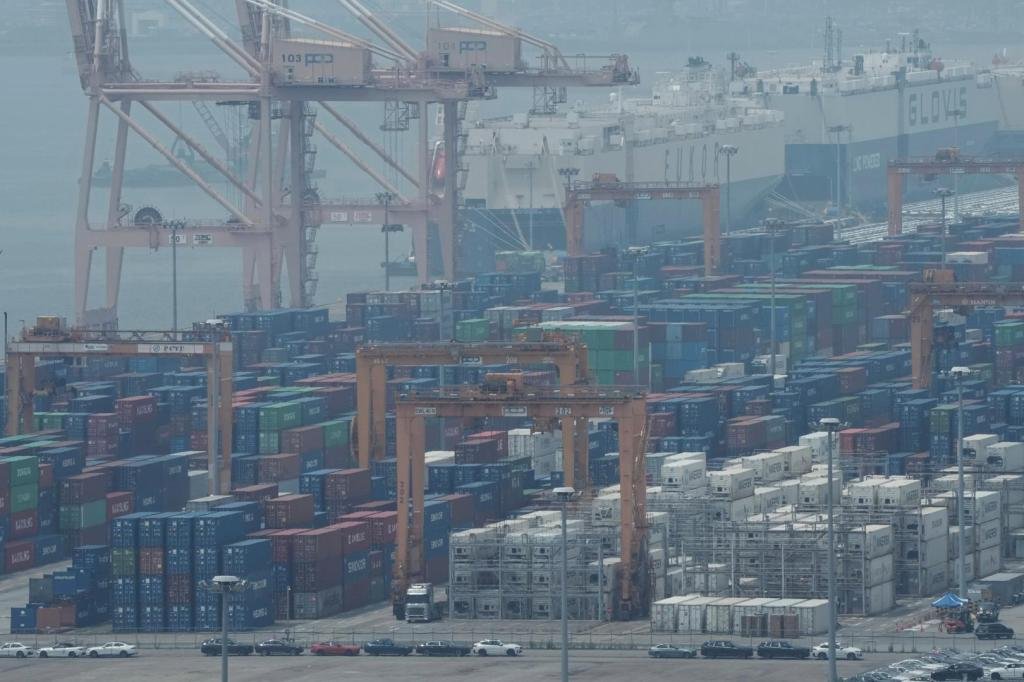Trump’s Trade Gamble: The Fallout of Tariff Negotiations
As the sun set over the Washington skyline, the air was thick with uncertainty in the hushed corridors of power. Just last spring, President Donald Trump and his advisors had made bold promises of a whirlwind of trade deals intended to reshape America’s economic landscape. However, as the deadlines approached, their optimism began to clash with the often brutal realities of global trade negotiations.
A Promised Blitz of Negotiations
In April, White House trade adviser Peter Navarro confidently predicted “90 deals in 90 days.” Countries around the globe were allegedly scrambling to agree to concessions to escape the massive import taxes that loomed ominously over their goods. Yet, as the months rolled on, only two deals materialized: one with the United Kingdom and another with Vietnam, raising eyebrows and skepticism in equal measure.
“The initial optimism was built on a shaky foundation,” noted Dr. Elizabeth Hargrove, a trade relations expert at the International Economics Institute. “Negotiating with dozens of countries simultaneously was always going to be unrealistic. It’s a complex web of interests and demands, and expecting quick resolutions is wishful thinking.”
Trade in Limbo: A State of Uncertainty
With the arrival of August, Trump extended the negotiation deadline yet again. “It’s a rerun, basically,” remarked William Reinsch, a former U.S. trade official. “Trump and his team don’t have the deals they want. So they’re piling on the threats.” As businesses waited on the edge of their seats to understand their future, decision-making on investments, contracts, and hiring ground to a halt.
The Reality of Negotiation
The optimistic forecast that Trump and his advisors initially painted was quickly juxtaposed with a stark reality. Taking into account over 200 countries, Trump himself admitted the impossibility of addressing each one substantively. The foundational structure of many trade agreements typically requires longer lead times and mutual concessions—elements that seemed lacking in this hasty approach.
- Threatening Tariffs: The concept of imposing blanket tariffs to elicit compliance is not new, but Trump’s personal branding on the tactic raised questions among economists and lawmakers alike.
- Reciprocal Agreements: By changing the fundamental rules of trade, Trump’s administration set a dangerous precedent. Tariff rates tailored to individual countries could undermine decades of multilateral agreements.
- Bigger Implications: The uncertainty surrounding ongoing negotiations began to whittle away at investor confidence, triggering global market reactions that have yet to stabilize.
Chad Bown, an economic adviser during the Obama administration, warned, “Countries can sense a power struggle. They’ll remain hesitant to reach deals as long as investigations into potential new tariffs loom overhead.”
The Lopsided Victories
Trump’s recent agreements reflect the broader theme of choosing easier targets over more formidable trading partners. The deal with Vietnam notably allowed U.S. products to enter its market duty-free, while placing a hefty tax on its exports to the United States. This was a clear demonstration of how the administration leveraged its threats more effectively against smaller economies.
“Negotiating with smaller countries is akin to bullying. They are often more willing to concede just to escape from the looming threat of tariffs,” said Dan McCarthy, a former official in the Office of the U.S. Trade Representative. “Larger economies, however, present a much tougher challenge.”
Geopolitical Ramifications
The fluid dynamics of trade agreements have significant geopolitical implications. As the Trump administration attempts to establish its influence, countries like Japan and South Korea will require assurances in return for concessions they might grant to the U.S. The stakes are particularly high; these nations are navigating their own complex political landscapes while valuing their relationships with global partners.
Ranged against this backdrop, the Trump administration’s strategy can seem more like a gamble than a well-crafted plan. “It’s a giant game of chicken,” Reinsch explained, emphasizing that both sides are locked in a tense standoff. “Each side is waiting for the other to blink.”
Time Will Tell
The extended deadlines have left global markets teetering on the brink of volatility. As countries are pressured into agreeing to terms that appear lopsided, the long-term repercussions of Trump’s tariff strategy remain unclear. Economists are keeping a close eye on developments, with data suggesting a gradual rise in protectionist measures across the globe as countries attempt to navigate the shifting sands of trade rules.
While there may be short-term victories, the pressure for a sustainable solution grows heavier with each passing day. The once-optimistic prediction of a multitude of trade deals has so far boiled down to a few partial victories, leaving nations to ponder the future of their trade relationships with the United States.
As the drama continues to unfold, one thing remains abundantly clear: in the world of global trade, the stakes have never been higher, and the outcome hangs precariously in the balance.





